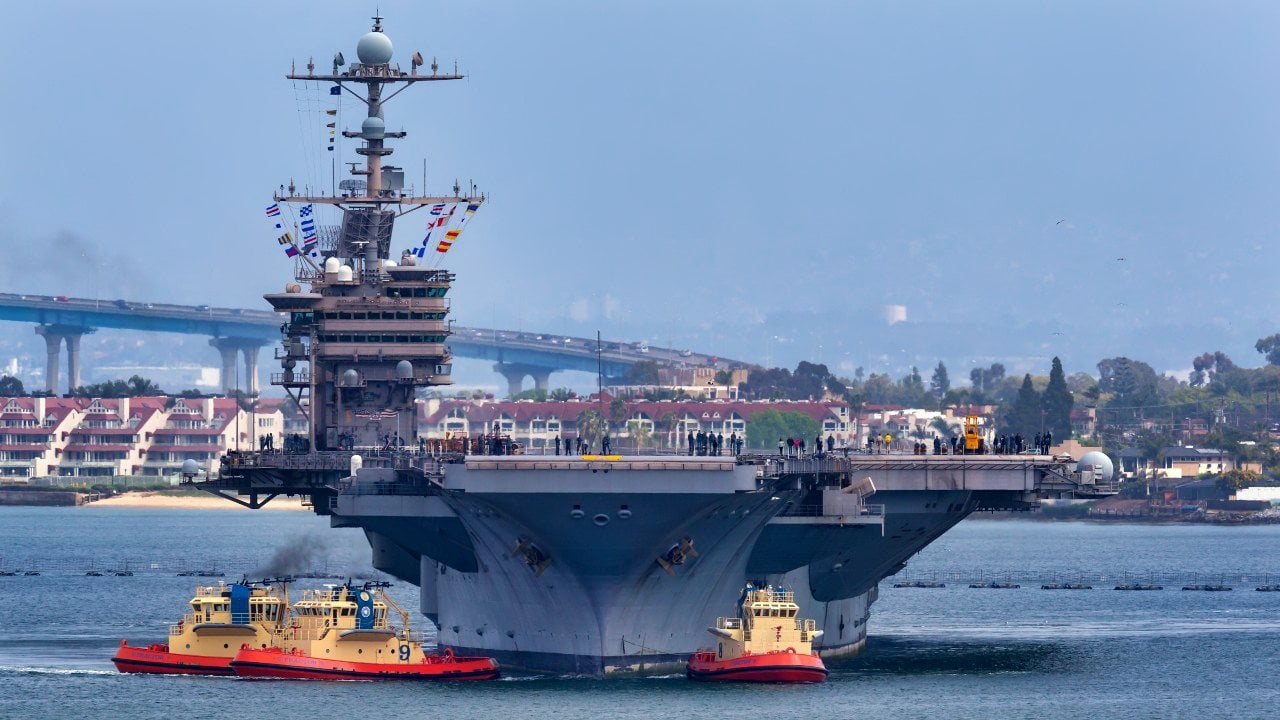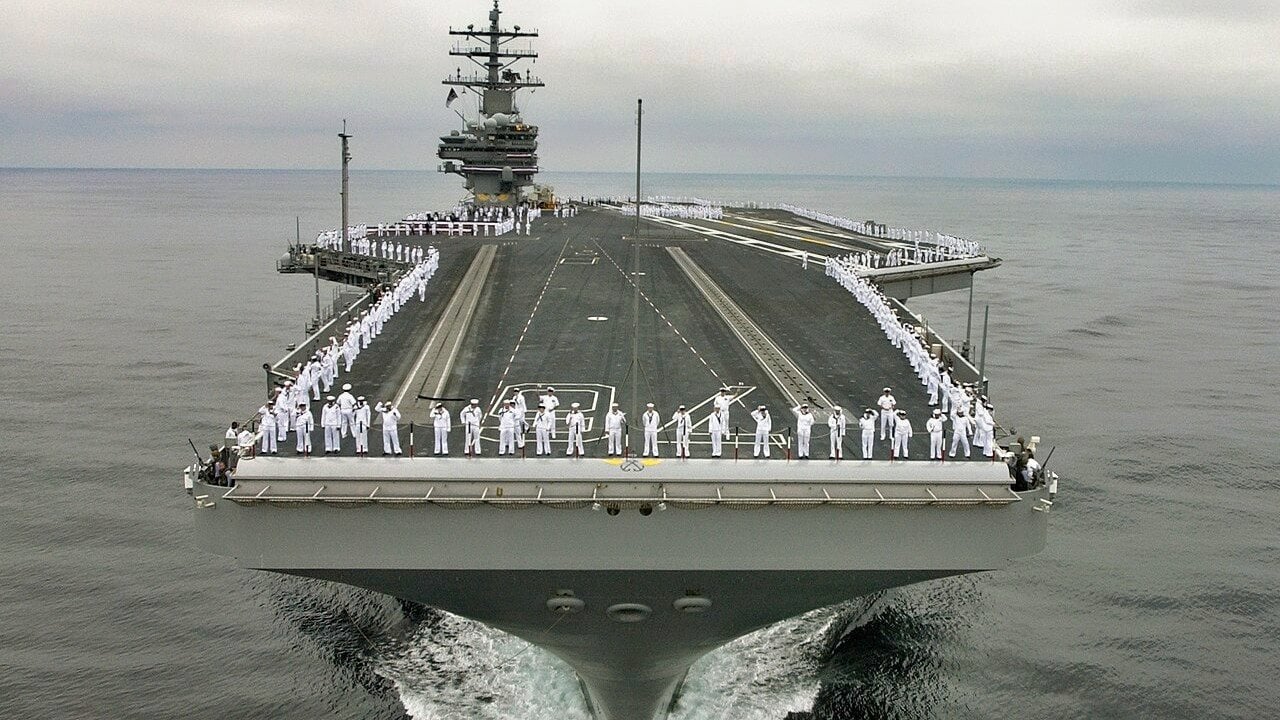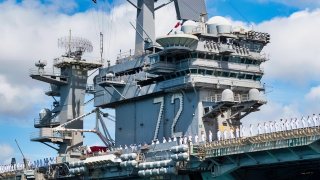What Is the 'Flank' Speed of a Navy Nimitz-Class Aircraft Carrier?
The Nimitz-class aircraft carriers are powerful, fast at flank speed, and maneuverable, but their effectiveness is increasingly challenged by China's sophisticated anti-access/area-denial (A2/AD) systems.
Summary and Key Points: The Nimitz-class aircraft carriers are powerful, fast at flank speed, and maneuverable, but their effectiveness is increasingly challenged by China's sophisticated anti-access/area-denial (A2/AD) systems.

-These systems can track and threaten U.S. carriers far beyond the range of their air wings, forcing the U.S. Navy to keep these valuable assets out of combat zones.
-Despite the carriers' capabilities, the growing threat of Chinese A2/AD technology means that the Nimitz-class carriers may be rendered less effective in a potential conflict in the Indo-Pacific region.
The Nimitz-class Carriers Are Fast. But Not Fast Enough to Defeat Chinese A2/AD
The Nimitz-class aircraft carrier is a great, lumbering beast with little in the way of real protection other than its airwing. And while this author has been highly critical of America’s infatuation with the flat top, American carriers are quite fast and maneuverable.
Flank Speed
The Nimitz-class carrier can sustain speeds as fast as 35 miles per hour, otherwise known as its flank speed.
Okay, so that sounds slow. You’re thinking about driving near that school zone, or around a tricky bend on an old country road. But we’re talking about a warship carrying a variety of warplanes, helicopters, and machines, and with a crew of nearly 6,000, that displaces an impressive 97,000 tons.
So, yeah, going 35 miles an hour at sea is highly impressive.
According to my colleague, Peter Suciu, “the Nimitz-class carriers populating the current fleet can move anywhere within a 700-square mile area within 30 minutes. After 90 minutes, that area grows to over 6,000 square miles” when traveling at flank speed.
Two powerful Westinghouse A4W nuclear reactors, producing 260,000 shp/194 MW, churn four steam turbines. These, in turn, propel four shafts and four propellers. As Suciu outlines, it takes approximately 10 minutes for a Nimitz-class aircraft carrier to reach its flank speed. Once it does, it might as well be an oversized rocket. The entire boat shakes with power. It becomes an unstoppable beast on the sea.
It's all very impressive.
But does it matter?
China’s A2/AD
The Chinese have developed one of the world’s most sophisticated anti-access/area-denial (A2/AD) capabilities. China’s A2/AD systems can reach hundreds of miles away from the shores of China and its manmade islands in the South China Sea. These capabilities include long-range ballistic missiles and even deadlier hypersonic weapons. They are linked to highly sophisticated and accurate tracking systems.
Sure, the Nimitz class is fast and can cover a lot of ground. But it is not invincible. The Chinese have proven they can track an American aircraft carrier from its point of origin all the way to its arrival in the Indo-Pacific theater.
Beyond that, the Chinese have shown, with relatively ancient systems like their Song-class diesel-electric submarine, that getting within torpedo range of an American nuclear-powered submarine is relatively easy. This is precisely what a Song-class sub did to USS Kitty Hawk in 2006.
Of course, USS Kitty Hawk did not belong to the Nimitz class. Nevertheless, China can hold America’s carrier force under threat. Especially considering any fight between the two sides would likely be waged close to China’s shores, giving Beijing’s forces serious strategic and tactical advantages over the Americans and their allies.
The Nimitz-class
America’s Nimitz-class aircraft carriers are modern technological marvels. But they are not invincible. The very fact that they are so advanced and impressive has forced America’s enemies to develop realistic countermeasures against these carriers.
Thus the advent of A2/AD – it was built to neutralize America’s carrier force.

Even if the U.S. doesn’t lose any carriers in a potential war with China, these carriers are far too valuable for Washington to risk in conflict. Given that China’s A2/AD systems can threaten an American flattop far beyond the range of that carrier’s airwing, U.S. carriers will have to be kept beyond the horizon.
This means that the Chinese military will have decisive advantages over the Americans in any fight for control of the western Indo-Pacific. Such a fight will favor China. It doesn’t matter how fast or maneuverable America’s impressive Nimitz-class carriers are. Until the Pentagon develops meaningful countermeasures against Chinese A2/AD systems, the carrier force will be rendered combat-ineffective.
Right now, it doesn’t look as though the Americans have figured out how to make the Nimitz class useful in any war with China.
Author Experience and Expertise: Brandon J. Weichert
Brandon J. Weichert, a National Interest national security analyst, is a former Congressional staffer and geopolitical analyst who is a contributor at The Washington Times, the Asia Times, and The-Pipeline. He is the author of Winning Space: How America Remains a Superpower, Biohacked: China’s Race to Control Life, and The Shadow War: Iran’s Quest for Supremacy. His next book, A Disaster of Our Own Making: How the West Lost Ukraine, is due October 22 from Encounter Books. Weichert can be followed via Twitter @WeTheBrandon.
All images are Creative Commons or Shutterstock. All photos are of various submarine styles.
From the Vault
Russia Freaked Out: Why the U.S. Navy 'Unretired' the Iowa-Class Battleships
Battleship vs. Battlecruiser: Iowa-Class vs. Russia's Kirov-Class (Who Wins?)
Image Credit: Creative Commons and/or Shutterstock.


